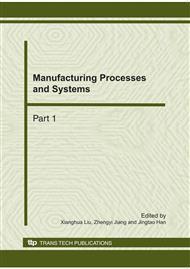p.841
p.845
p.849
p.854
p.859
p.865
p.869
p.873
p.877
Effects of Processing Parameters on the Temperature Field of Melts in Aluminothermic Reaction to Prepare Bulk Nanocrystalline Fe3Al
Abstract:
Making use of the finite element analysis software ANSYS, we calculated the effects of different processing parameters on temperature, cooling rate and superheating time of Fe3Al melt in aluminothermic reaction to prepare bulk Nanocrystalline Fe3Al. The results showed that, with the increase of substrate thickness and reduction of reactant’s quantity, cooling rate of the Fe3Al melt at the initial cooling stage became larger, while the melt purification became worse. With the increase of argon pressure, the Fe3Al melt cooled a little quicker. The cooling rate of melt cooled by glass substrate was lower than that of the melt cooled by 1045 steel and Cu substrate, while the melt purification became better. With the increase of Al2O3, Fe3Al diluents content, the cooling rate at the initial cooling stage became lower, and the melt purification became worse. The experiment verified that the calculated results were in good coincident with the experimental results.
Info:
Periodical:
Pages:
859-864
Citation:
Online since:
October 2010
Authors:
Price:
Сopyright:
© 2011 Trans Tech Publications Ltd. All Rights Reserved
Share:
Citation:


